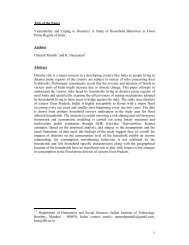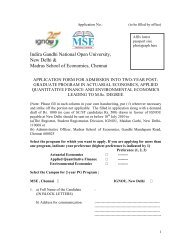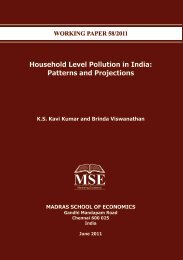Performance of Flagship Programmes in Tamil Nadu
Performance of Flagship Programmes in Tamil Nadu
Performance of Flagship Programmes in Tamil Nadu
Create successful ePaper yourself
Turn your PDF publications into a flip-book with our unique Google optimized e-Paper software.
Chapter 3<br />
PRADHAN MANTRI GRAM SADAK YOJANA<br />
Government <strong>of</strong> India launched the Pradhan Mantri Gram Sadak Yojana (PMGSY), a 100<br />
percent centrally sponsored scheme on 25 th December 2000. This scheme aims to<br />
provide all-weather roads (with necessary culverts and cross dra<strong>in</strong>age structures) to all<br />
rural habitations with population 1000 and more dur<strong>in</strong>g 2002-2003 and to all rural<br />
habitations with population 500 and more dur<strong>in</strong>g 2004-2007, i.e., at end <strong>of</strong> 10 th Plan. 5 50<br />
percent <strong>of</strong> the cess on high speed diesel (HSD) was earmarked for this scheme.<br />
The target is to provide all-weather road connectivity to over 1.60 lakh eligible<br />
unconnected habitations at an estimated <strong>in</strong>vestment <strong>of</strong> Rs. 60,000 crore. The works<br />
under this scheme are executed by the State Governments and monitored by the M<strong>in</strong>istry<br />
<strong>of</strong> Rural Development through the National Rural Roads Development Agency (NRRDA.<br />
This scheme has been implemented <strong>in</strong> different phases: Phase I <strong>in</strong> 2000-01, Phase II <strong>in</strong><br />
2001-02, Phase III <strong>in</strong> 2002-03, Phase IV <strong>in</strong> 2004-05, Phase V <strong>in</strong> 2005-06, Phase VI <strong>in</strong><br />
2006-07, Phase VII <strong>in</strong> 2007-08, Phase VIII <strong>in</strong> 2008-09 and Phase IX <strong>in</strong> 2009-10 and<br />
Phase X <strong>in</strong> 2010-11.<br />
3.1 F<strong>in</strong>ancial and Physical <strong>Performance</strong>s <strong>of</strong> PMGSY <strong>in</strong> India<br />
Table 3.1 shows the f<strong>in</strong>ancial and physical performances <strong>of</strong> the scheme dur<strong>in</strong>g 2001-02<br />
to 2009-10. Under this scheme, not only new connectivity roads are built, but also<br />
exist<strong>in</strong>g roads are upgraded. The total expenditure <strong>in</strong>curred by the centre under this<br />
scheme <strong>in</strong>creased from Rs. 4,725 crore <strong>in</strong> 2001-02 to Rs. 20,323 crore <strong>in</strong> 2009-10.<br />
However, the actual expenditure <strong>in</strong> each year as percent <strong>of</strong> the amount cleared by the<br />
centre (fund utilization ratio) decl<strong>in</strong>ed cont<strong>in</strong>uously from 92.3 percent <strong>in</strong> 2001-02 to 32.3<br />
percent <strong>in</strong> 2008-09.<br />
5 S<strong>in</strong>ce rural road connectivity is a key component <strong>of</strong> rural development and it promotes access to economic and social<br />
services thereby generat<strong>in</strong>g <strong>in</strong>creased agricultural <strong>in</strong>come and productive employment opportunities, Government <strong>of</strong><br />
India launched this scheme as part <strong>of</strong> its poverty reductions strategy and to synergise various flagship programmes<br />
implemented across districts <strong>in</strong> the country.<br />
19



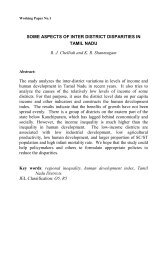

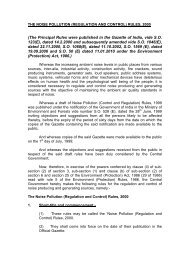

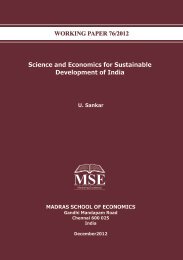
![Curriculum Vitae [pdf] - Madras School of Economics](https://img.yumpu.com/49878970/1/190x245/curriculum-vitae-pdf-madras-school-of-economics.jpg?quality=85)
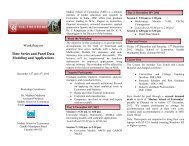
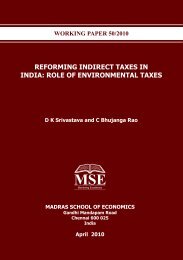
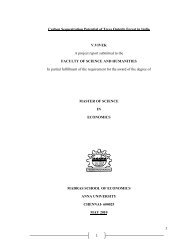
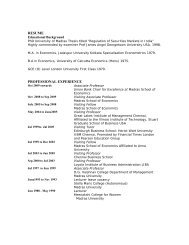
![Curriculum Vitae [pdf] - Madras School of Economics](https://img.yumpu.com/48715201/1/184x260/curriculum-vitae-pdf-madras-school-of-economics.jpg?quality=85)
